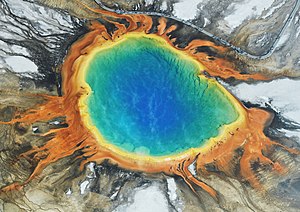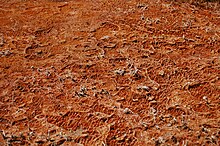Thermophile

Athermophileis an organism—a type ofextremophile—that thrives at relatively high temperatures, between 41 and 122 °C (106 and 252 °F).[1][2]Many thermophiles arearchaea,though some of them arebacteriaandfungi.Thermophiliceubacteriaare suggested to have been among the earliest bacteria.[3]
Thermophiles are found in variousgeothermallyheated regions of theEarth,such as hot springs like those inYellowstone National Park(see image) anddeep seahydrothermal vents,as well as decaying plant matter, such aspeat bogsandcompost.
Thermophiles can survive at high temperatures, whereas other bacteria or archaea would be damaged and sometimes killed if exposed to the same temperatures.
Theenzymesin thermophiles function at high temperatures. Some of these enzymes are used inmolecular biology,for example theTaqpolymeraseused inPCR.[4]"Thermophile" is derived from theGreek:θερμότητα(thermotita), meaningheat,andGreek:φίλια(philia),love.
Comparative surveys suggest that thermophile diversity is principally driven by pH, not temperature.[5]
Classification
[edit]Thermophiles can be classified in various ways. One classification sorts these organisms according to their optimal growth temperatures:[6]
- Simple thermophiles: 50–64 °C (122–147 °F)
- Extreme thermophiles 65–79 °C (149–174 °F)
- Hyperthermophiles 80 °C (176 °F) and beyond, but not below 50 °C (122 °F)
In a related classification, thermophiles are sorted as follows:
- Facultative thermophiles (also called moderate thermophiles) can thrive at high temperatures, but also at lower temperatures (below 50 °C (122 °F)), whereas
- Obligate thermophiles (also called extreme thermophiles) require such high temperatures for growth.
- Hyperthermophilesare particularly extreme thermophiles for which the optimal temperatures are above 80 °C (176 °F).

Many of the hyperthermophilic Archaea require elementalsulfurfor growth. Some areanaerobesthat use the sulfur instead ofoxygenas anelectron acceptorduringcellular respiration (anaerobic).Some arelithotrophsthat oxidize sulphur to createsulfuric acidas an energy source, thus requiring the microorganism to be adapted to very lowpH(i.e., it is anacidophileas well as thermophile). These organisms are inhabitants of hot, sulfur-rich environments usually associated withvolcanism,such ashot springs,geysers,andfumaroles.In these places, especially in Yellowstone National Park,zonationof microorganisms according to their temperature optima occurs. These organisms are often colored, due to the presence ofphotosyntheticpigments.[citation needed]
Thermophile versus mesophile
[edit]Thermophiles can be discriminated frommesophilesfrom genomic features. For example, theGC-contentlevels in the coding regions of some signature genes were consistently identified as correlated with the temperature range condition when the association analysis was applied to mesophilic and thermophilic organisms regardless of their phylogeny, oxygen requirement, salinity, or habitat conditions.[7]
Fungal thermophiles
[edit]Fungi are the only group of organisms in the Eukaryota domain that can survive at temperature ranges of 50–60 °C.[8]Thermophilic fungi have been reported from a number of habitats, with most of them belonging to the fungal orderSordariales.[9]Thermophilic fungi have great biotechnological potential due to their ability to produce industrial-relevant thermostable enzymes, in particular for the degradation of plant biomass.[10]
Gene transfer and genetic exchange
[edit]Sulfolobus solfataricusandSulfolobus acidocaldariusare hyperthermophilic archaea. When these organisms are exposed to theDNA damaging agentsUV irradiation,bleomycinormitomycin C,species-specific cellular aggregation is induced.[11][12]InS. acidocaldarius,UV-induced cellular aggregation mediates chromosomal marker exchange with high frequency.[12]Recombination rates exceed those of uninduced cultures by up to three orders of magnitude. Frols et al.[11][13]and Ajon et al.[12](2011) hypothesized that cellular aggregation enhances species-specific DNA transfer betweenSulfolobuscells in order to provide increased repair of damaged DNA by means ofhomologous recombination.Van Wolferen et al.,[14]in discussing DNA exchange in the hyperthermophiles under extreme conditions, noted that DNA exchange likely plays a role in repair of DNA via homologous recombination. They suggested that this process is crucial under DNA damaging conditions such as high temperature. Also it has been suggested that DNA transfer inSulfolobusmay be a primitive form of sexual interaction similar to the more well-studiedbacterial transformationsystems that are associated with species-specific DNA transfer between cells leading to homologous recombinational repair of DNA damage[citation needed].
See also
[edit]References
[edit]- ^Madigan MT; Martino JM (2006).Brock Biology of Microorganisms(11th ed.). Pearson. p. 136.ISBN0-13-196893-9.
- ^Takai T; et al. (2008)."Cell proliferation at 122°C and isotopically heavy CH4production by a hyperthermophilic methanogen under high-pressure cultivation ".PNAS.105(31): 10949–51.Bibcode:2008PNAS..10510949T.doi:10.1073/pnas.0712334105.PMC2490668.PMID18664583.
- ^Horiike T; Miyata D; Hamada K; et al. (January 2009)."Phylogenetic construction of 17 bacterial phyla by new method and carefully selected orthologs".Gene.429(1–2): 59–64.doi:10.1016/j.gene.2008.10.006.PMC2648810.PMID19000750.
- ^Vieille, Claire; Zeikus, Gregory J. (March 2001)."Hyperthermophilic Enzymes: Sources, Uses, and Molecular Mechanisms for Thermostability".Microbiology and Molecular Biology Reviews.65(1): 1–43.doi:10.1128/MMBR.65.1.1-43.2001.ISSN1092-2172.PMC99017.PMID11238984.
- ^Power, J.F., Carere, C.R., Lee, C.K., Wakerley, G.L., Evans, D.W., Button, M., White, D., Climo, M.D., Hinze, A.M., Morgan, X.C. and McDonald, I.R., 2018. Microbial biogeography of 925 geothermal springs in New Zealand. Nature communications, 9(1), p.2876.
- ^Stetter, K. (2006). "History of discovery of the first hyperthermophiles".Extremophiles.10(5): 357–362.doi:10.1007/s00792-006-0012-7.PMID16941067.S2CID36345694.
- ^Zheng H; Wu H (December 2010)."Gene-centric association analysis for the correlation between the guanine-cytosine content levels and temperature range conditions of prokaryotic species".BMC Bioinformatics.11(Suppl 11): S7.doi:10.1186/1471-2105-11-S11-S7.PMC3024870.PMID21172057.
- ^Rajasekaran, A. K.; Maheshwari, R. (1993-09-01)."Thermophilic fungi: An assessment of their potential for growth in soil".Journal of Biosciences.18(3): 345–354.doi:10.1007/BF02702992.ISSN0973-7138.S2CID46013720.
- ^Patel, Hardi; Rawat, Seema (2021),"Thermophilic fungi: Diversity, physiology, genetics, and applications",New and Future Developments in Microbial Biotechnology and Bioengineering,Elsevier, pp. 69–93,doi:10.1016/b978-0-12-821005-5.00005-3,ISBN9780128210055,S2CID224847697,retrieved2022-06-02
- ^van den Brink, Joost; Facun, Kryss; de Vries, Michel; Stielow, J. Benjamin (December 2015)."Thermophilic growth and enzymatic thermostability are polyphyletic traits within Chaetomiaceae".Fungal Biology.119(12): 1255–1266.Bibcode:2015FunB..119.1255V.doi:10.1016/j.funbio.2015.09.011.ISSN1878-6146.PMID26615748.
- ^abFröls S; Ajon M; Wagner M; Teichmann D; Zolghadr B; Folea M; et al. (November 2008)."UV-inducible cellular aggregation of the hyperthermophilic archaeon Sulfolobus solfataricus is mediated by pili formation"(PDF).Mol. Microbiol.70(4): 938–52.doi:10.1111/j.1365-2958.2008.06459.x.PMID18990182.
- ^abcAjon M; Fröls S; van Wolferen M; Stoecker K; Teichmann D; Driessen AJ; et al. (November 2011)."UV-inducible DNA exchange in hyperthermophilic archaea mediated by type IV pili"(PDF).Mol. Microbiol.82(4): 807–17.doi:10.1111/j.1365-2958.2011.07861.x.PMID21999488.
- ^Fröls S; White MF; Schleper C (February 2009). "Reactions to UV damage in the model archaeon Sulfolobus solfataricus".Biochem. Soc. Trans.37(Pt 1): 36–41.doi:10.1042/BST0370036.PMID19143598.
- ^van Wolferen M; Ajon M; Driessen AJ; Albers SV (July 2013). "How hyperthermophiles adapt to change their lives: DNA exchange in extreme conditions".Extremophiles.17(4): 545–63.doi:10.1007/s00792-013-0552-6.PMID23712907.S2CID5572901.
External links
[edit]- "Thermoprotei: Extreme Thermophile".NCBI Taxonomy Browser.
- How hot is too Hot? T-Limit Expedition
